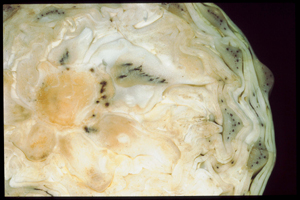Black Rot Disease in crucifers
Xanthomonas campestris pv. campestris
Damage symptoms
The first symptoms become visible ten to 14 days after infection and are manifested as irregular, yellowish discolorations along the leaf margins. As the infection progresses, these discolorations enlarge to form V-shaped brown spots with a yellow edge. The leaf veins are discolored black in the process. As a result, dry rot develops. The leaves are eventually gradually shed. In the final stage of the disease, the vascular bundles in the stalk show a closed black ring. In cabbage, cauliflower and savoy cabbage, the outer leaves turn yellow and eventually fall off. Furthermore, black spots may appear on the flower of cauliflower. On stored cabbage, the symptoms may sometimes intensify during storage.


Host plants
Xanthomonas campestris pv. campestris occurs on all cultivated cruciferous species, for example on cabbage plants such as cabbage, cauliflower and savoy cabbage, but also on radish or radish. The bacterium also attacks a large number of weeds from the crucifer family, such as shepherd's purse.
Propagation and transmission
The bacteria can persist in seeds, on seed bearers, winter cabbages, cruciferous weeds, and for up to two years on infected plant debris in the soil. They enter the plant through stomata, water gaps (hydathodes), or wounds and spread throughout the plant via the woody guard tissue (xylem). The gummy polysaccharide xanthan is formed. This polysaccharide and the multiplying bacteria eventually clog the vessels of the plant. In the crop, the disease is spread by cultural operations and splashing water droplets. Transmission with the seed is possible.
Last updated: 03.11.2021
automatically translated